The single leg stance is commonly known as one of modern yoga asanas — Vrikshasana, or Tree pose. Lesser-known is the origin of this stance: it traces back to Sthanu-vrata, an ancient practice of asceticism which embodies key pillars of Indian culture.
Schematic description of the Universe or its abstract model in the view of the ancients are not the central concern of the article. The key issue is macrocosmic realm manifestation through microcosmic human actions, an absolutely realizable concept which the Indians used to apply in their lives and inner experience.
Ekapada is the term for unipedalism. Eka means one and pada is a polysemantic word with several meanings referring to the same topic. The article examines each meaning and considers diverse semantic features of this ascetic practice.
Who stands alone, motionless as a tree,
The whole universe is filled by the Purusha
Shvetashvatara Upanishad, 3, 9
1. Pada as part /quarter
Vedic theory of the Universe has a fundamental principle: the Universe has four subdivisions, yet only one-fourth accounts for the manifest world. Certain aspects of this principle and their corresponding concepts permeate the entire Indian culture.
So mighty is his greatness; yea, greater than this is Purusha.
All creatures are one-fourth of him, three-fourths eternal life in heaven.
With three-fourths Purusha went up: one fourth of him again was here.
Rigveda, X, 90, 3-4
This one-fourth of the manifest world, in turn, consists of three parts: heaven, earth, and air. In other words, the crucial point is that the divine is represented by one part in three spheres of the manifest world, whereas it is represented by three parts in the unmanifest world.
These are the four conditions, and the fourth is the greatest of all.
In the three walks the one-footed Brahman, and the three-footed walks in the last.
Maitrayaniya Upanishad, VII, 11
2. Pada as foot / leg
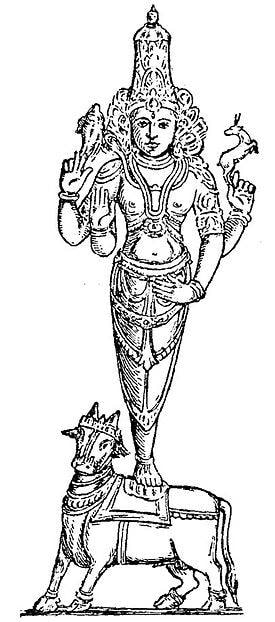
In ancient times, there was a tendency to associate macrocosmic phenomena with theriomorphic images and microcosmic phenomena with anthropomorphic ones. That is why Purusha (a cosmic being who was sacrificed to create all life) was portrayed as a four-legged animal, naturally. The three legs (or three parts, three quarters) form other dimensions and only one leg refers to the manifest world. This kind of distribution is easily represented by the following analogy: projection of a three-dimensional object (a leg) would look like a flat print on a two-dimensional plane. It is not by chance that pada means both foot and footprint – indeed, Indian tradition is widely known to honor footprints, prints of a three-dimensional foot.
Over time, theriomorphic image of the Universe structure almost completely disappeared from Indian mythology leaving behind the custom of four-legged animal sacrifices (although this custom acquired different meaning afterwards). There is only a vague mention left of the first and most important cosmogonic image: Aja Ekapada is a one-legged goat directly related to the Universe creation but with a lost meaning and, therefore, an uncertain role.
Thereon reposeth Aja Ekapāda.
He with his might have established Earth and Heaven.
Atharvaveda, XIII, 1, 6
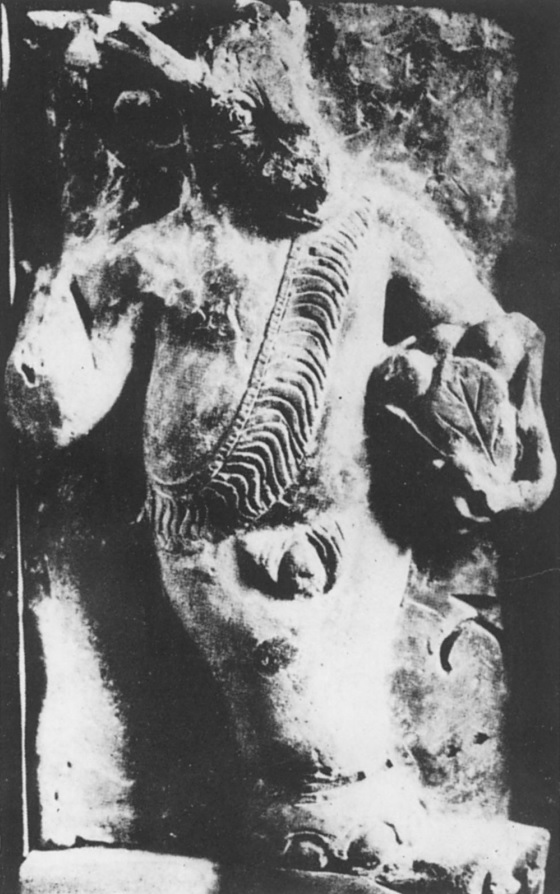
Interestingly, when the sacrificial nature of the world was replaced by abstract philosophical concepts, Purusha also began to be perceived as a silent and inactive principle, a passive observer of world metamorphoses rather than a sacrificial lamb.
At the same time, the meaning of the term “Aja” expanded because a goat was no longer comprehensible in the new “intellectual” philosophical context. Aja acquired a homonym and became an “unmanifest”, “unborn” cosmic principle. It is clearly matched with unipedalism – indeed, standing on one leg is a vivid expression of neutrality and non-incarnation.
But either way, the leg belonging to the manifest world needed an explanation on the microcosmic and, consequently, anthropomorphic level.
Aja (meaning unborn) becomes an epithet of Shiva (and at the same time Vishnu and Brahma) who also inherits unipedalism as a divine part manifested in this threefold world (heaven, earth, and air). Shiva Ekapada is depicted standing on one leg, sometimes on top of a lying body which belongs to sacrificed Purusha.
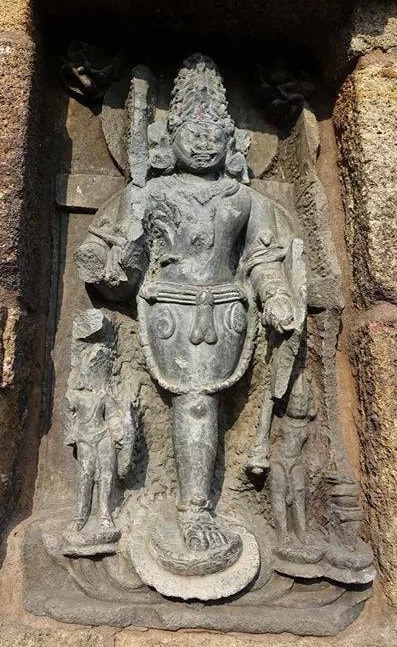
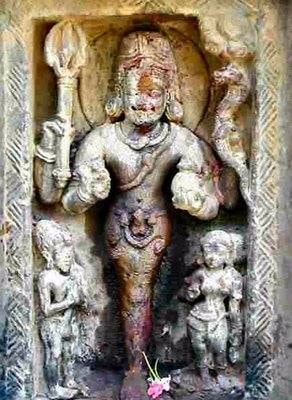
One of Purusha’s body parts became the three realms of human world which is now under responsibility of anthropomorphic Shiva. Shiva «grows» out of dead Purusha and begins to represent the universe. Within the Indian tradition, vertical position was perceived as a symbol of life, as opposed to horizontal position. The upright position is a basic symbol of life and vitality, and in general the right way of things – dharma. It reminds a «proper» straight smoke from a fire signifying that a sacrifice reaches its destination.
Further philosophical interpretations and innovations that address the combination of vertical and horizontal as different Shiva-Shakti relations are beyond the scope of this article.
Stand up erect to help us, unreluctant,
what time the gloom of night brightens to morning.
Rigveda, VI, 24, 9
3. Pada as pillar / column
What deserved special worship is the verticality principle by which space itself [as well as air between heaven and human earth] is «extended» and created. Skambha is a pillar, a fulcrum, a foothold. Skambha derives from the verb skambh (to prop up, to strengthen).
Upheld by Skambha’s power these two, the heaven and the earth, stand fast.
Skambha is all this world of life, whatever breathes or shuts an eye.
Atharvaveda, X, 8, 2
Skambha set fast these two, the earth and heaven,
Skambha maintained the ample air between them.
Skambha established the six spacious regions:
this whole world Skambha entered and pervaded.
Atharvaveda, X, 7, 35
Skambha is also the supreme being identified with Brahman as well as the fulcrum of the Universe itself. This axis mundi (the world axis currently pointing toward the Polaris) is the cosmic law which establishes a highest order, including on Earth.
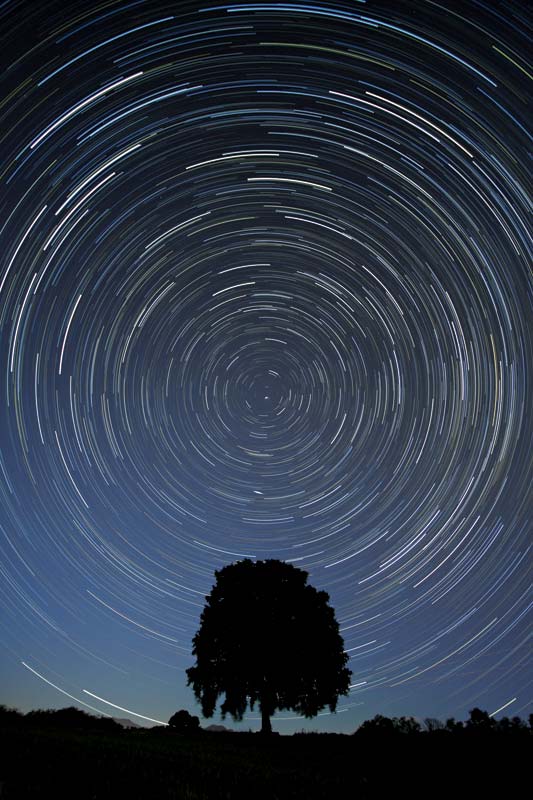
In Skambha cosmic heat rests,
the worlds and Holy Law repose on him.
Atharvaveda, X, 7, 29
This essential principle used to place a special emphasis on any vertical constructions, phenomena and concepts. For example, the sacrificial pillar Yupa (sacrifices were tied to it) served as the embodiment of the world axis and thus linked the realms of humans and gods.
All gods rely on Skambha,
Like branches spreading around the trunk of a tree.
Atharvaveda, X, 7, 38
4. Pada as root
Ascetics came to such an understanding of verticality not only through philosophical and religious reflections: everything in the world testified to it. One of the terms for a tree is padapa which literally means drinking through roots or feet. This term reflects the image of a tree which conducts the power of sunlight through leaves and branches to roots while absorbing and evaporating soil moisture in the opposite direction.
Another manifestation of axis mundi is “the world tree”. The sacred asvattha is either rooted in heaven and entangles the whole world with its branches or grows in two directions simultaneously: both heaven and earth. Asvattha is also known as peepal / pippala (Ficus religiosa).
The three-footed Brahman has its root upward,
the branches are ether, wind, fire, water, earth, &c.
This one Asvattha by name, the world, is Brahman.
Maitrayaniya Upanishad, VI, 4
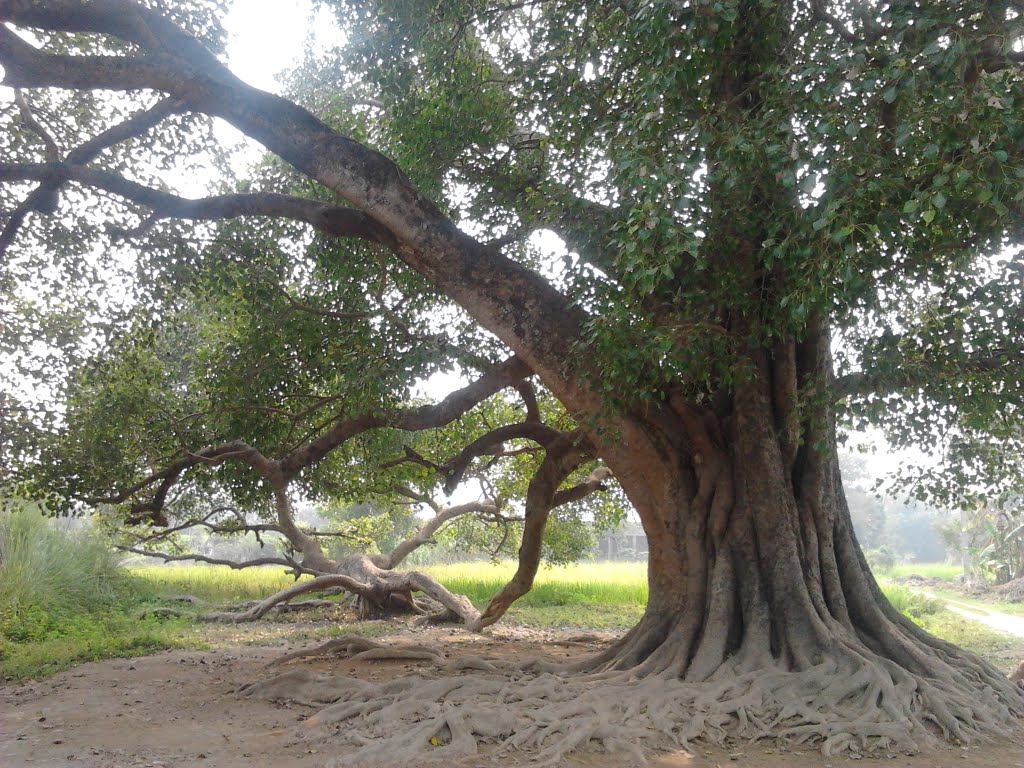
Another term closely related to the concept of the world tree is vanaspati (literally lord of the forest, the great and mighty forest tree). The Yupa pillar was made of this particular tree which is why vanaspati has also the meaning a sacrificial pillar. Unlike vrksa which simply means a tree and belongs to the profane world, vanaspati is a term which belongs to the sacred realm.
Another meaning of vanaspati is an ascetic. In fact, ascetics developed close relations with plants, trees and even reeds. The Kesin ascetics and the Vratyas (non-brahmanical Aryans) mentioned in the Rigveda showed particular interest in the image of a reed growing in or near water. This is not surprising, since the vertical which strengthened the realms was rooted in primordial waters.
He who knows the golden reed standing in the sea, he verily is in secret Prajapati
Atharvaveda, X, 7, 41
The mighty Being, in the world’s centre,
from the cosmic heat came out on the waters’ surface
Atharvaveda, X, 7, 38

This archetype also appeared in cosmogonic mythology in the image of a mountain resting on a turtle’s back floating on the ocean surface. The image of a bird standing on one leg was popular due to the same reasons as in the case with a reed.
A bird standing on one leg is the living embodiment of mysterious hamsa, a goose-like swan and Brahma’s vahana. Sometimes the bird expresses Brahma himself, Shiva, Vishnu and, not surprisingly, the Sun.
Hamsa, what time he rises up,
leaves in the flood one foot unmoved.
If he withdrew it there would be no more tomorrow or to-day,
Never would there be night, no more would daylight shine or morning flush.
Atharvaveda, XI, 4, 21

It is not by chance that a marabou stork (a “one-legged” bird) represented an ascetic in the Arab East. The bird’s name derives from the word murabit (an ascet who lives in a ribat). The greater adjutant (Indian marabou) was endowed with exclusive supernatural privileges and was thought to bear a Brahmin’s soul.
One cannot help noting the resemblance of a reed to a stork’s leg: something related to heaven (and to the higher principle) grows on a thin stem coming out of water.
One name to a reed is sara. It is a sort of a reed which was used in arrow production. Sara derives from śṛ (to destroy).
He anoints (the eyes) with a reed-stalk, for the reed is a thunderbolt.
It is one with a tuft, in order to chase away the evil spirits
Satapatha Brahmana, III, I, 3, 13
Indra hurled this thunderbolt against Vṛtra. […]
This is the real nature of śara stalks.
The thunderbolt is indeed śara stalks
Taittiriya Samhita 6.1.3.3–4
5. Pada as ray
The above-mentioned phenomena were implicitly connected with Agni (fire):
- Aja goat (aja – Agni’s vahana),
- Skambha (containing Tapas flame),
- the sacrificial pillar Yupa (mediator between realms like Agni),
- «the lord of the forest» (the tree used to build sacrificial pillars),
- a pipal tree (used to make the lower plank, or sometimes both, to produce sacrificial fire),
- a reed (the lightning arrow),
- a bird (the symbol of the Sun).
Sunrays falling down from above, a plume of smoke from a sacrificial flame rising up, or lightning striking simultaneously in both directions – these are the three forms of Agni representing the three worlds: heaven, earth and air, respectively. All these images found their embodiment in various ways of expressing the cosmogonic myth.
Agni, wise, welcome in our holy synods.
Like Savitar he hath lifted up his splendour,
and like a builder raised his smoke to heaven.
Rigveda, IV, 6, 2
One of them is the image of Indra (he is Agni, too) who defeated Vritra with the help of a vajra (a club, a staff, related to a pole; another image is lightning «pulling apart» heaven and earth), eliminated all obstacles (vṛtra is an obstacle from vṛ to hinder) and divided heaven and earth.
He who fixed fast and firm the earth that staggered,
and set at rest the agitated mountains,
Who measured out the air’s wide middle region
and gave the heaven support,
He, men, is Indra.
Rigveda, II, 12, 2
High heaven unsupported in space he stablished:
he filled the two worlds and the air’s mid-region.
Earth he upheld, and gave it wide expansion.
Rigveda, II, 15, 2
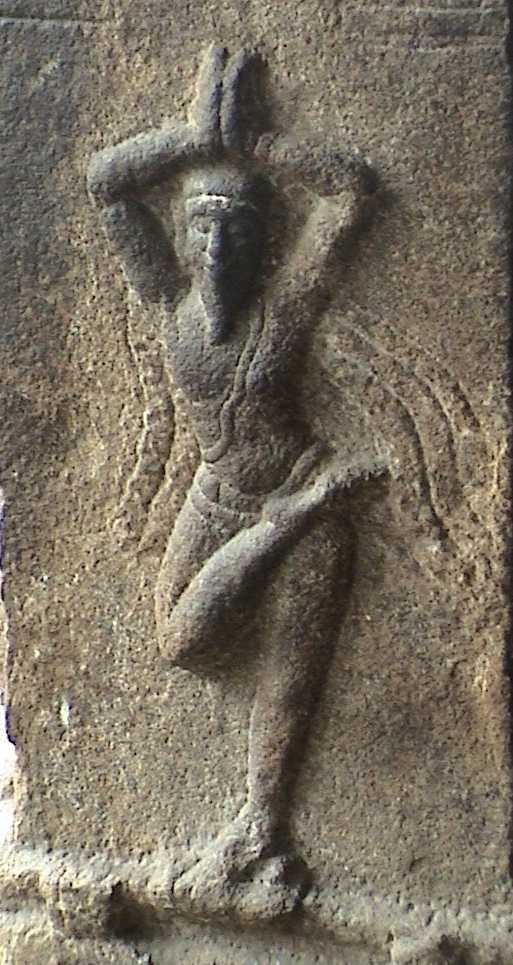
But once fortified, heaven must be held permanently otherwise it falls back to earth. Every day at dawn, Indra erects a pillar which divides heaven and earth. This is why Vedic texts used a special «continuous» verb form without a finite past tense to describe such cosmogonic stories. In other words, the world is created and renewed every day: this perception of time and life was inherent to Vedic hymns and was not strange to ascetics as well. It is not surprising that ascetics considered it their duty to join in the important mission of maintaining peace and establishing cosmic law and order, the dharma. Dharma is something that is established or firm.
6. Pada as path
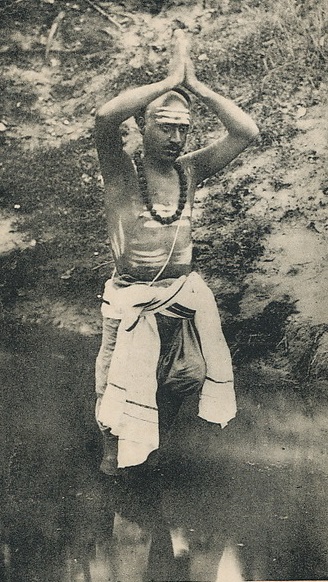
Sthanu means to stand firmly. Vrata means a firm purpose. It was this term [rather than Vrikshasana] which described epic deeds of asceticism: standing motionless on one leg for a long time, usually a year.
Sthanu also means a lance. It is not by chance that a lance used to be the symbol of the ascetic community Akhara (an analogy with the European notion of lance fournie is possible). Sthanu is a tree trunk and also refers to Shiva, the lord of Yoga, or Maheshvara.
It is no accident that all meanings and connotations reviewed above relate to the theme of world creation and maintenance, sacrifices, weapons (a club, the vajra sword, a reed-arrow, a lance) and their use in some way. The point is that combat [like sacrifice] used to be a means of maintaining dharma, restoring order and removing obstacles and represented the sacred act of sacrifice, including self-sacrifice.
In this regard, the role of a warrior, especially a warrior ascetic, was to preserve the existing order of things, or dharma. Therefore, a warrior must be both a destroyer and a creator. By destroying enemies, he removes an obstacle and establishes a cosmic order he is responsible for. In this sense, a warrior is a creator: by preserving or recreating the old order, he directs his will in tune with the will of the creator god, or the victim god. At the same time, an ascetic [as a human being] is unable to perform divine acts or substitute the god. An ascetic can solely «remove obstacles» or allow the «primordial waters» to flow by standing firm and motionless. He removes himself, becomes a mere mediator, a pillar between heaven and earth. He is a detached, silent, immobile, unrealized and unmanifest co-creator of cosmic process.
Yet the pillar erected by Indra [which separates heaven and earth] stands in air which is ruled by Vayu, the deity of wind and breath.
To breathing, air space, birds — to Vāyu,
their supreme Lord — glory to them!
Atharvaveda, VI, 10, 2
Getting inside a continuous process requires a sudden awareness of oneself being within this process which is what makes the moment lasting. This process may be represented by something “sublime” such as watching the sunrise or the sunset, or any random day-to-day situation. Entering this state is often accompanied by changes in breathing which is perceived as fading or even disappearing.
The cosmic hamsa swan is also a breathing cycle similar to images of a tree or a reed “drinking through a leg”: ham and sa form the mantra “I am That”. It is not the hero that begins to uphold the pillar and establish dharma. The hero disappears leaving behind his conscious breath. This no longer human breath joins the unified rhythm of nature, ascent and descent of waters, a plume of smoke and a sunray. It joins the general cycle of sacrifice like Purusha [a primordial sacrifice] by interacting with the world, renewing it and itself.
You are the step of Vishnu, killing opponents, honed with breath,
inflamed by man. I follow the breath.
Atharvaveda, X, 5, 35
7. Pada as step / pace / tempo
Gods refused to help Indra in performing a feat, even the Maruts abandoned him. Only Vishnu came to help Indra who was holding heaven and earth and performed three steps that encompass, define, and seal the universe Indra created. Pada means a step, a trace and a footprint. It was pada used by Vishnu to measure the three worlds.
Hey, friend Vishnu, step wider!
Hey, heaven, give the vajra space to brandish!
Rigveda, VIII, 100, 12
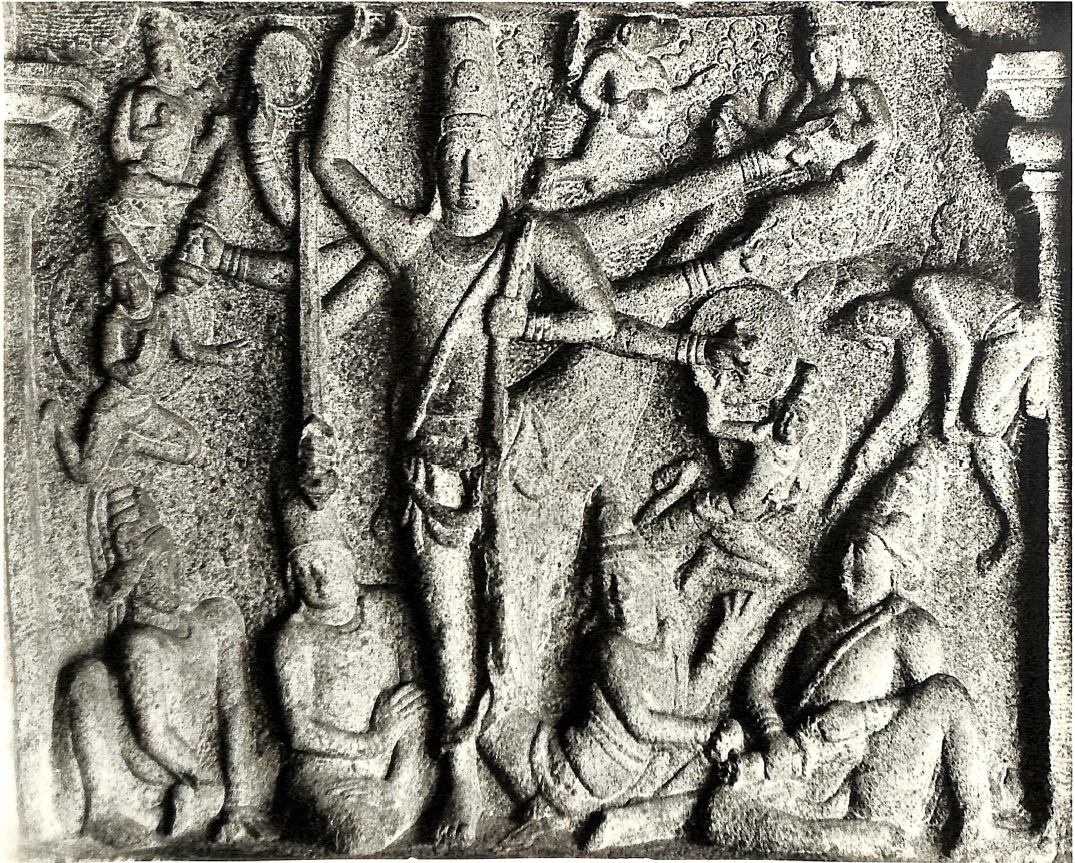
This is what the principle of combining an immovable state of rest (the pillar erected by Indra), on the one hand, with dynamic action (Vishnu’s three steps) on the other looks like. This principle is also reflected in martial arts of Indian ascetics.
The footwork in most Indian martial arts is represented by Pentra (a movement, a maneuver) featuring three specific steps [even when the meaning, purpose, and feasibility have long been lost and only the form remains]. The peculiarity of these steps is that at the moment of each step, the foot stepping on the ground must be ingrown into it like a root of a tree. The leg and the body, on the contrary, grow out of the ground like a reed-arrow or a tree-club. Zeno’s infamous arrow paradox endeavours to prove that a moving object is actually at rest. In the same way, the warrior is motionless during each step which are, in fact, stitches made with a needle by a tailor sewing together heaven and earth. In modern terms, this “ingrowth” occurs when all masses and forces acting upon the body are projected into the foot at the moment the foot is placed on the ground [forces also include those of the weapon used or forces of counteraction if the weapon meets an obstacle]. In other words, the performer can stop this exercise and freeze without inertial continuation of the movement at any moment of movement [which is a step]. It is the principle of gathering the body into a «pillar» analogous to Zeno’s «resting arrow”. After all forces acting upon the body recoil upon the foothold, the next act of «growing up» occurs [when normal force is used]. A step with such an internal structure can be visualized as a step on a taut surface: the force for each subsequent step and related actions comes from straightening the elastic material compressed by the previous step. From outside this movement technique may even appear like a little bouncing but it is due to the way each foot interacts with the ground during contact. Both phases can be combined in one step (one footwork) or separated by different steps, and in this case one step may end the previous phase and start a new one. In other words, forces acting upon the body are passed to earth and taken from earth through legs [roots] (but there is only one «root» at one single moment of the «resting arrow»), conducted through a body [a tree trunk] into arms [branches] either from earth to heaven or in the opposite direction.
Such bidirectional forces are consistent with the breath which begins to be «felt» and be perceived as part of the movement or even the movement itself. As a matter of fact, the study of breathing behavior in various situations (vital breathing and, consequently, the study of life in one’s body) was the main ascetic practice and not only in martial arts. After all, a breath is Vayu, the god of wind, who controls breathing and life forces of a body.
Vāyu. Filling our hearts with health and joy,
may wind breathe his balm on us
May he prolong our days of life.
Rigveda, X, 186, 1
At the beginning of the practice, it seems to learners that they perform actions with a weapon or hands and thus affect their opponents. In time, as hand actions become inextricably linked to steps and escape the direct control of consciousness, learners begin to feel that they simply «step around» or «trample» their opponents. The next phase comes when steps themselves disappear from the screen of inner perception and only the directions of breathing remain. Actions are embodied through these directions.
As in the case of the «resting arrow,» nothing changes: a breathing cycle runs in a body as on one unmoving pole. This does not interfere with taking three steps, establishing dharma and restoring justice through enabling gods to act.
Ye, Indra-Vishnu, have conquered,
never have you been conquered:
never have either of you been vanquished.
Rigveda, VI, 69, 8
8. Pada as the last of a series
Indra, in fact, did suffer defeats:
Devas said to the wielder of the thunderbolt, “O Śatakratu, discharge the thunderbolt.” Śakra who was told thus by Devas, hurled the thunderbolt against Skanda.
The thunderbolt discharged by him hit the right side of Skanda. On account of the blow from the thunderbolt the right side of the noble-souled Skanda split and another person was born. He was youthful. He had golden armour and other equipments. He held a spear and had divine ear-rings. He became well-known as Śakha. He too roared in a mysteriously wonderful manner. Then once again the infuriated Indra pierced the chest of Skanda. There also a person like him was born. He became well-known as Naigameya. The three persons beginning with Skanda roared and rushed at Indra. Thereupon Indra abandoned the thunderbolt. With palms joined in reverence, he sought refuge in him. Skanda, the most excellent one, granted freedom from fear to him as well as to his army …
All the Devas bowed down to him when Śrī conjoined him and said, “O Lord of golden complexion, be the benefactor of all the worlds. May you be our Indra, O Lord, for the sake of the welfare of the three worlds”.
Skanda Purana, Maheśvara Khaṇḍa, Kaumārikā Khaṇḍa, chapter 29
Skanda (Murugan in South Indian culture) is the god of war who appeared comparatively late in Indian mythology. He not only replaced Indra as the hero god and the warrior king but, eventually, was identified with God Almighty. Skand means to leap, to jump, to move, to attack.
Skanda is the god of a new entity and a new cultural period. In order to link him with continuous Indian divine system, he was embedded in mythological context as the heir to two genealogical lines, Rudra and Agni. In Rudra’s lineage he is the heir to warrior skills necessary to destroy enemies of dharma. As the heir of Agni, he represents the sacrificial aspect and is the ruler of the three worlds. Merging understandings of Skanda historically coincided with the battle for supremacy, or rather the interaction between two centers of influence, the palace and the temple, and between two groups, the kshatriyas and the brahmans. This interaction led to combining martial and philosophical aspects in Skanda’s image. This complied with ideals of ascetics, heirs of Vratjas: worshippers of Indra and Rudra, creators of the kshatriya republics, merchant guilds, and later military monastic orders. Sangha referred to a state entity and also a religious community and a troop of ascetics.
O Lord of Yogins, O Skanda, be victorious!
Skanda Purana, Maheśvara Khaṇḍa, Kaumārikā Khaṇḍa, chapter 29
Skanda-Murugan occupied and continues to occupy a dominant position in minds and hearts of worshippers of the god of war mainly in southern India. But most esteemed among warrior ascetics was Hanuman who received all his powers from Vayu, his father.
9. Pada as trail / sign

If each first step of pentra is tied to the same center point, pentra will twist into an easily recognizable symbol – the swastika. In this case, rotation will be double: a body rotates in one direction while rays of a swastika rotate in the opposite one. This movement is considered the most difficult. Following it, air and four cardinal directions “submit” and a mind no longer needs to decide how to step, where to move and how to react.
Yet a swastika is not only the symbol of a footprint but also represents rotation of the sun and the world axis – the celestial pole or the Universe.
This symbolically completes the downward cycle of divine manifestation stabilizing and establishing dharma and, at the same time, the upward vector of human endeavor, the realization of the earthly level through the divine level.








